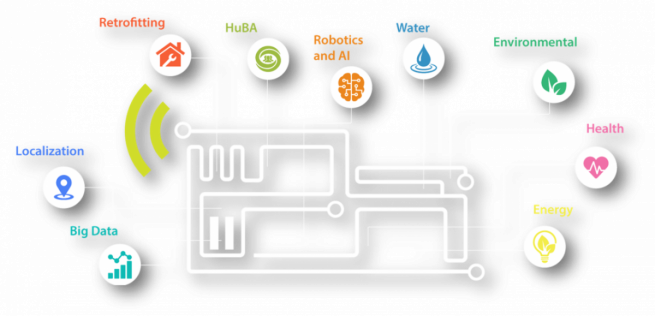Test Lab Facilities
Test Lab: AAU Microgrid IoT Laboratory
The AAU Microgrid-IoT laboratory is located in Aalborg University, Aalborg, Denmark. It is used as a testing lab and a demonstration of an intelligent residential microgrid with smart sensors/devices/appliances for cross-domain applications.
The Residential Microgrid Energy Management System (RMEMS) in addition with the smart sensors, devices, and appliances allow the users to have full access to the system´s information and provide the users the option to remotely control the system. Smart sensors, devices, and appliances operate in an integrated way and provide the real-time data to the RMEMS to achieve demand side management, energy cost reduction, energy efficiency improvement, optimal energy usage, and so on. It is expected that intelligent residential microgrid will enhance the overall system performance and users experience, reaching new levels of flexibility, controllability, comfort and efficiency.
The AAU Microgrid-IoT laboratory consists of four parts: a living room, a kitchen, a DC room and a control room. 2 kW roof-mounted PV power system and a 2 kW wind turbine are installed. AC and 2-ring DC power supplies are distributed in the whole lab. District and electrical underfloor heating systems are equipped. Smart sensors, devices, and appliances from different vendors for domains, such as Gorenje smart oven and refrigerator, Tinymesh door sensors, PlacePod parking sensors are all installed and running in an integrated manner. Electronic appliances (laptops, cellphones, LED lights, home entertainment systems, and white goods) are already placed as residential loads and provide real living scenarios.
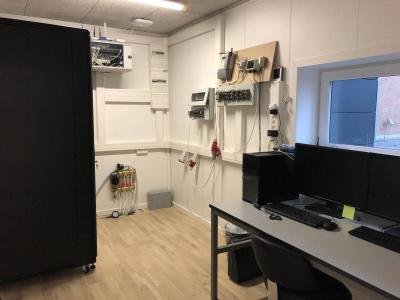
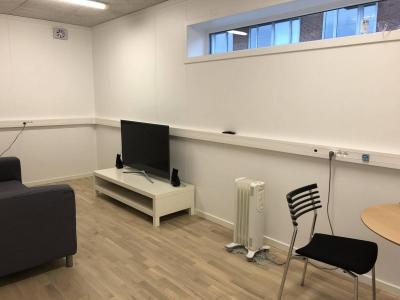
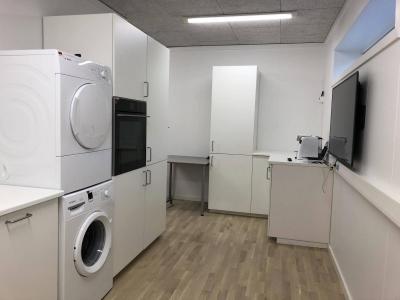
Download here the testing scenario video prepared for review meeting
Test Lab: ATOS IoT Laboratory
The lab addresses technological contributions in the scope of IoT components, connectivity, platforms and services integration, fostering the usage of open and standard technologies, while also ensuring wider adoption and implementation of the IoT paradigm. The lab is moreover composed by a multidisciplinary technological team targeting embedded systems, sensorized devices, open web technologies and the application of best-practices, agile developments and continuous integration through a self-designed platform and integration services.
Ongoing activities:
ATOS lab could provide a heterogeneous cluster of different ARM platforms managed through an infrastructure and software management system; enabling developers to implement and test easily and simulating production environments
Test Lab: UNIKL Test Laboratory
In order to validate the correct behaviour of the VICINITY in the early development phases, that is before actual deployment in the field, a model-based development process is reasonable. With the Test Lab at University of Kaiserslautern (UNIKL), this will be met to an extent, that “virtual” devices are connected to the VICINITY Server. That way real use-cases can be simulated, analysed and the correct behaviour can be validated before deployment. An overview of the overall structure of the virtual Environment is shown in below figure.

A network Simulator is directly connected to the VICINITY-Server on one side, and to a variety of real and simulated devices on the other side. The devices themselves are communicating via different Network Gateways. They can be pure virtual devices/gateways (marked in red) or real existing ones. Both are integrated seamlessly into the VICINITY, enabling the simulation and evaluation of any possible IoT Scenario. Performance, scalability and runtime behaviour will be evaluated with the ultimate goal of simulating a “virtual Oslo” (see Use case – Intelligent Building System).
Ongoing activities:
Not all devices in the IoT are directly connected to the Internet. For those devices, an IoT Gateway is necessary to establish the connection between devices and the VICINITY (or any Cloud) Server.
Currently UNIKL is evaluating existing hardware- and software platforms for IoT Gateways. A full list of considered platforms is shown in Project deliverable D2.1.
Furthermore, an IoT Developer Survey from April 2016 by The Eclipse IoT Working Group, IEEE IoT and AGILE IoT showed, that the most dominant messaging protocols in existing IoT deployments are HTTP (REST) and MQTT. These will be analysed in terms of scalability and performance in order to evaluate their value and possible use for the VICINITY.
Test Lab: CERTH IoT Laboratory
CERTH Test laboratory comprises of a dedicated experimental Smart House. Within 2017, this infrastructure (https://smarthome.iti.gr) has been included in the available assets of the Institute. Inspired by its current Director, this new facility, named nZEB Smart Home, provides a rapid prototyping & novel technologies demonstration infrastructure resembling a real domestic building where occupants can experience actual living scenarios while exploring various innovating smart IoT-based technologies.
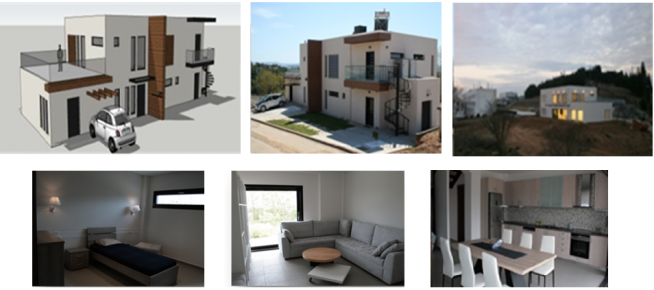
The Smart House is a real house simulation building where occupants can experience actual living scenarios, equipped with a vast variety of sensors, actuators and smart devices and intelligent robots, being capable to provide an useful test bed for the experimentation of all foreseen use case scenarios of the VICINITY framework.
